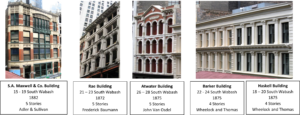 By Brian Kelly, Class of 2019
By Brian Kelly, Class of 2019
Editor’s note: This is the second part of Brian’s story about Martin L. and Martin A. Ryerson, Adler & Sullivan and S. A. Maxwell. CLICK HERE to read Part 1.
Dankmar Adler was born in Stadtlengsfeld, Thuringia, Germany on July 3, 1844. Ten years later, the Adlers emigrated to Detroit. In May 1861, they relocated to Chicago and by mid-year Dankmar was employed by Augustus Bauer, among Chicago’s most prominent early architects. Adler served in the Civil War with the First Illinois Light Artillery as an engineer. He was wounded at the battle of Chickamauga, Georgia. After leaving the army, Adler partnered with Ashley Kinney from 1866 to 1871. In 1871, he partnered with Edward Burling. In 1872, Dankmar Adler married Dila Kohn.
Louis Henri Sullivan was born September 3, 1856, to Andrienne and Patrick Sullivan. (Louee, not Louis and Henri, never Henry. Louis was very particular.) The Sullivans relocated to Chicago in 1968. At 16, Louis enrolled at MIT. In January 1873, Louis left the program and joined his grandfather in Philadelphia. He was employed by Frank Furness, who enjoyed a burgeoning practice. Later that year, Louis returned to his Chicago home and was employed by William Le Baron Jenney. In 1874, Louis headed to Paris, enrolled at Ecole des Beaux-Arts, returning to Chicago a year later. He was employed by John Edelman as a freelance designer who introduced him to Dankmar Adler. LHS was eager to make his mark!
In 1876, Louis Henri Sullivan was hired by Burling & Adler as a freelance designer on the Sinai Temple interior. In May 1880, he was retained as draftsman and designer by Dankmar Adler who enjoyed a growing residential practice. Two years later he was given a partial partnership and the firm was renamed D. Adler & Company. In mid-1883, Louis was given full and equal partnership; the firm rebranded as Adler & Sullivan. This partnership continued until July 16, 1895.
When Martin L. Ryerson began his building program, he hired Burling & Adler, continued with Adler when he was in solo practice, and awarded additional commissions when the firm became Adler & Sullivan. In total, Ryerson built five loft buildings of various sizes. These were speculative investments: between five and six stories with open, flexible floor plans that allowed for space customization based upon the needs of the tenant.
Today, we know the first Ryerson commission as the Jewelers’ Building on the east side of Wabash Street between Madison and Monroe. This identity came later. In fact, over the years and before the jewelry merchants, Wabash was known for its booksellers, musical instruments, and cafeterias.
Ryerson’s first tenant was Samuel Augustus Maxwell, a printed paper merchant: wholesaler, retailer, and printer. S.A. Maxwell and Co. grand opened in July 1882 after relocating from Bloomington, Illinois. The merchant redirected his firm in 1891 to focus on home décor. Maxwell revolutionized interior decorating via easy-to-install wall coverings in an expansive assortment, with full-service support. S.A. Maxwell became the largest wall-paper merchant in the world. S.A. Maxwell left his mark.
Today, the S.A. Maxwell & Co. Building is the oldest Adler & Sullivan building in existence. A large shopfront on the street level, with four stories above. Exterior walls of pressed brick and Berlin sandstone with iron supports. An ornamental parapet, in front of a flat roof, finishes the façade. Per Rochelle Elstein’s biography of Dankmar Adler, “Adler was proud of its being the first Chicago building to have an elevator.”

The façade design was practical and efficient for a deep building leased to a tenant that required retail and wholesale showrooms, and light manufacturing. The double-hung windows in the center bay delivered light and air. They are separated by narrow iron mullions to create three openings on floors 2 – 4 and six windows on the fifth floor.
The masonry is polychromatic: red brick and tan sandstone echoing the aesthetic of Sullivan’s first employer, Frank Furness of Philadelphia. Sullivan added visual details on the façade by experimenting with exotic, stylized organic motifs.

Adler took advantage of emerging building technologies to increase window openings and glass pane size. The central bay combined façade elements into a single composition. A&S genius is emergent. Together Adler and Sullivan left their mark.
The uniqueness Adler & Sullivan’s revolutionary design is best understood when seen in the context of the remaining post-fire structures on Wabash. Next door, the Rae Building by Frederick Baumann in 1872. Across the street, the Haskell and Barker buildings by Wheelock and Thomas in 1875 and the Atwater Building by John Van Osdel in 1877.

The S.A. Maxwell Building was recently restored. The adaptive reuse is a joint venture of Peerless Development and Honore Properties. It’s been converted into a 39-room boutique hotel, Sonder. Sonder is a hybrid, part hotel and part host ala Airbnb. The street level is restored to mimic its original appearance.

Martin L. Ryerson, who revolutionized the lumber industry, applied the same talent and vigor to his real estate investments. After the Maxwell Building came the Gage Building also in 1882; the Gray, Kingman and Collins Building in 1885; the Keith Brothers Building in 1887; and James H Walker & Co. Building in 1889.
Ryerson commissioned more Adler & Sullivan commercial buildings than any other client. Each was a productive investment. As Cass Gilbert, one of the first celebrity architects said, “The building is merely the machine that makes the land pay.”

The Ryersons did not live in a residence designed by Adler & Sullivan; they will spend eternity in one. Martin A. commissioned A&S to build the family mausoleum at Graceland Cemetery. The Ryersons left their mark upon Chicago.

______________________________________________________________________________

CLICK HERE for more stories on The Bridge.



